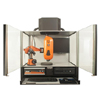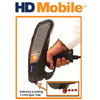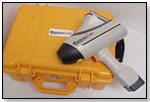|
|
Keep the Lead Out "Import Guard" Finds Trouble Fast
Since Aug. 2, when Mattel began recalling toys tainted with lead, toy industry professionals have wrestled with the question of how to identify hazardous materials sooner. Some of the recalled toys had been in children’s hands since 2003. STORED LEAD CAN RE-INSULT SOFT TISSUE “Exposure to lead at a young age has the potential to limit children's intellectual development,” Richard Jacobs, chemist and toxic element specialist at the FDA, told TDmonthly Magazine. 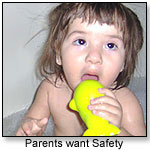 And since the heavy metal is stored in the bones, it can re-insult soft tissue throughout life, especially as bones decalcify through the aging process or due to diseases such as osteoporosis. Pregnant women may even pass lead onto their fetuses if they aren’t ingesting enough minerals to prevent their bones from decalcifying during pregnancy. And since the heavy metal is stored in the bones, it can re-insult soft tissue throughout life, especially as bones decalcify through the aging process or due to diseases such as osteoporosis. Pregnant women may even pass lead onto their fetuses if they aren’t ingesting enough minerals to prevent their bones from decalcifying during pregnancy.“There’s not a great understanding yet of what future potential health impacts lead may have when the individual has accumulated large amounts of lead in the bone,” continued Jacobs. “The overall idea is to keep lead exposure and absorption as low as possible.” But lead can be anywhere: garden hoses, electrical cords and — though it’s been banned by the CPSC for 30 years — sometimes in children’s playthings. “Most companies know the law and know how to test for lead,” stressed Scott Wolfson, spokesman for the CPSC. “It’s very important throughout the entire supply chain that control and adherence to federal standards be met.” He pointed out that companies also have an obligation to conform to voluntary standards as well, or risk a recall if they are found to be noncompliant.  FASTER TESTING, ON THE SPOT FASTER TESTING, ON THE SPOTThe Import Guard, a handheld x-ray fluorescence analyzer that was developed by Innov-X Systems, Inc. to help electronics companies comply with the European RoHS Directive, offers a way for manufacturers to supplement current tests quickly and easily. Unlike similar devices, the Import Guard uses no radioactive sources, but effectively detects the presence of even minute amounts of lead, cadmium, mercury, total chromium, and total bromine often present as polybrominated biphenyl (PBB) and polybrominated diphenyl ether (PBDE) flame retardants, all of which are prohibited under the RoHS Directive. The recent recalls have made clear that the device also might be useful in the toy industry, explained Innov-X’s CEO, Don Sackett. “We have thousands of instruments already in the field, including in China,” Sackett told TDmonthly.  While the Import Guard runs about $30,000 per unit, it can be leased for approximately $1,900 per week. Secondary companies who are able to operate the equipment are also available, usually at a fee of approximately $500 per day. While the Import Guard runs about $30,000 per unit, it can be leased for approximately $1,900 per week. Secondary companies who are able to operate the equipment are also available, usually at a fee of approximately $500 per day.Tests take just 10 to 15 seconds to perform, according to Tom Rainone, president of CMS Associates, which uses Innov-X’s equipment to test for RoHS-banned substances in various industries. “An X-ray source excites the electrons of whatever element the device is looking at. A sensor detects these electrons and identifies the substances that are present,” he explained. “If the banned substance is present, the results jump right out at you.” In addition to lead, he said, toy companies should be concerned about the presence of cadmium, which may be used as the pigment in yellow, orange or red plastics and paints. TESTING CENTERS WILL ASSURE PARENTS For parents who are panicked that their children may have suffered irreparable damage from lead-tainted toys, it might be helpful to remember that generations of Americans grew up playing with lead toy soldiers and eating canned goods sealed with lead. 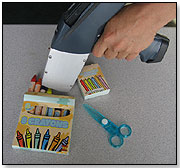 “There was concern even in the 1930s about poisoning from lead soldiers,” pointed out Richard O’Brien, author of 20 books on toys, including “Collecting Toy Soldiers” and “The Story of American Toys.” “I do know a lot of collectors who still seem hale and hearty, and more than a few workers in toy-soldier factories who survived into their senior years without any noticeable problems.” “There was concern even in the 1930s about poisoning from lead soldiers,” pointed out Richard O’Brien, author of 20 books on toys, including “Collecting Toy Soldiers” and “The Story of American Toys.” “I do know a lot of collectors who still seem hale and hearty, and more than a few workers in toy-soldier factories who survived into their senior years without any noticeable problems.”But to alleviate present concerns, Sackett said his company used the device on toys as soon as the recalls were announced. Worried co-workers raided their children’s toy chests and brought in armfuls of dolls, toys and games to be tested. “The advantage of the Import Guard is that a single operator can test a lot of toys — up to 20 to 30 percent in single batch,” Sackett pointed out. Since the results are immediate, there’s no need to wait to hear back from a laboratory. “If you test 10,000 toys in a batch and all are negative, you might choose to move on,” Sackett told TDmonthly. He added that the Import Guard is the only instrument of its type that is accepted for use by the Environmental Protection Agency for testing the presence of lead in paint used in pre-1978 housing. 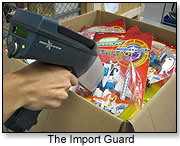 “We’re contacting toy manufacturers and retailers around the country to sponsor toy testing. If they provide the site, we’ll donate an instrument and an operator for a day so that anyone who brings us toys can get them tested and get results,” Sackett concluded. “We’re contacting toy manufacturers and retailers around the country to sponsor toy testing. If they provide the site, we’ll donate an instrument and an operator for a day so that anyone who brings us toys can get them tested and get results,” Sackett concluded.To contact Innov-X about setting up toy-testing sites, please contact: Innov-X Systems (781) 938-5005 Attn: Andrea Tepolt  Writer's Bio: ALISON MAREK is an award-winning writer, director and cartoonist whose work has been published by Fairchild Publications and DC Comics (Piranha Press), broadcast on Showtime and other cable networks, and viewed worldwide in film festivals. See her short films and print work on www.alisonmarek.com. Watch her nefarious villains in the web series www.MuggsMovers.com. Get inspired by her cartoons "Daily ARFFirmations to Unleash Your Inner Fido" at www.ARFFirmations.com. Phew! And then ... Read more articles by this author Writer's Bio: ALISON MAREK is an award-winning writer, director and cartoonist whose work has been published by Fairchild Publications and DC Comics (Piranha Press), broadcast on Showtime and other cable networks, and viewed worldwide in film festivals. See her short films and print work on www.alisonmarek.com. Watch her nefarious villains in the web series www.MuggsMovers.com. Get inspired by her cartoons "Daily ARFFirmations to Unleash Your Inner Fido" at www.ARFFirmations.com. Phew! And then ... Read more articles by this author |
| |||||||||||||||||||||||||||||||||
Disclaimer Privacy Policy Career Opportunities
Use of this site constitutes acceptance of our Terms of Use.
© Copyright 2025 PlayZak®, a division of ToyDirectory.com®, Inc.

